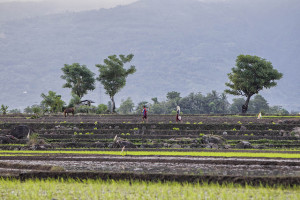By Anne M Larson, Principal Scientist, Center for International Forestry Research (CIFOR)

Climate mitigation strategies involving forests are likely to involve restrictions on forest access and conversion – and are thus as likely to affect women as well as men living in forest communities.
CIFOR’s recent research on 23 REDD+ initiatives in six countries, covering about half of the total area under REDD+ globally, found that restrictions on forest access and conversion are being implemented at almost all sites.
The risk of harm to women may be the most obvious reason to consider a gendered approach to climate mitigation strategies, but it is certainly not the only one. As many others have pointed out, “gender neutral” or “gender blind” approaches are likely to exclude women, exacerbate poverty and undermine the long-term success of climate initiatives; interventions that fail to address inequities are likely to perpetuate them. At the same time, gender-responsive approaches are more likely to support equitable and long-term solutions.
 Early research into these same REDD+ initiatives found that women were far less informed than other villagers about the project (Larson et al. 2015), but two years later this gap appears to have closed. This is somewhat reassuring, but the question only focuses on the most minimal measure of “participation”. We still found a 16% gap in differences in participation in the decision to approve the initiative, and a 25% gap in participation in design or implementation.
Early research into these same REDD+ initiatives found that women were far less informed than other villagers about the project (Larson et al. 2015), but two years later this gap appears to have closed. This is somewhat reassuring, but the question only focuses on the most minimal measure of “participation”. We still found a 16% gap in differences in participation in the decision to approve the initiative, and a 25% gap in participation in design or implementation.
I won’t rehash the evidence that women use forests differently, or that male (or even female) leaders may not represent the needs and interests of a broader spectrum of village women. I want to focus on a different message here.
There are at least two important reasons why gender is so difficult for policies and projects to address. First, gender is deeply context specific. We cannot assume that women are weak or overlooked, but we also cannot assume that they are fully engaged as equals in village decisions or in access to assets and resources. Gender roles – and the gendered nature of land and forest resource rights and access – vary by country, culture and even village.
Second, gender – or sexism, like so many other “isms” – is deeply personal. Engaged action research, such as through CIFOR’s work in Adaptive Collaborative Management, has found that improving the public role of women cannot ignore their private role. As one woman leader in a miskitu village in Nicaragua said recently: “In order for women to participate, they have to find a way to negotiate with and convince their husbands.” This is important for practical reasons (men have to assume some of the burden of household chores and childcare), as well as complex social ones (sanctions can include domestic violence).
 What we learn from gender research is the importance of in-depth, long-term engagement – the kind that builds trust and a solid foundation for change over time. Change cannot be top-down. Gender relations cannot be “fixed” by blueprint policies or projects.
What we learn from gender research is the importance of in-depth, long-term engagement – the kind that builds trust and a solid foundation for change over time. Change cannot be top-down. Gender relations cannot be “fixed” by blueprint policies or projects.
This point is not new – not for gender, not for “development,” nor for projects more generally. Recent research on multilevel governance in five countries demonstrates the importance of local buy-in to ensure local legitimacy – and, hence, the initiatives’ long-term sustainability.
Don’t get me wrong. We need to work at all levels and in multiple spheres. “Ownership” of climate mitigation initiatives matters from the national to regional and at all levels all the way to local villages. And so far we don’t have it.
No single approach is enough. We need policies, enforcement, incentives, institutional changes; we need government, the private sector and civil society. But it is the people on the ground, living in and near forests, who are the main subjects of REDD+ initiatives to date, and these men and women are the ones who will decide the forests’ fate.
Hail donors! The kind of funding and long-term engagement needed for change flies in the face of the current pursuit of short-term impacts, measured with simplified indicators. Let the deeply contextual and personal lessons of gender research help define the path forward. This is not the time for technical fixes. Fundamental long-term and sustainable change has to be bottom-up.











